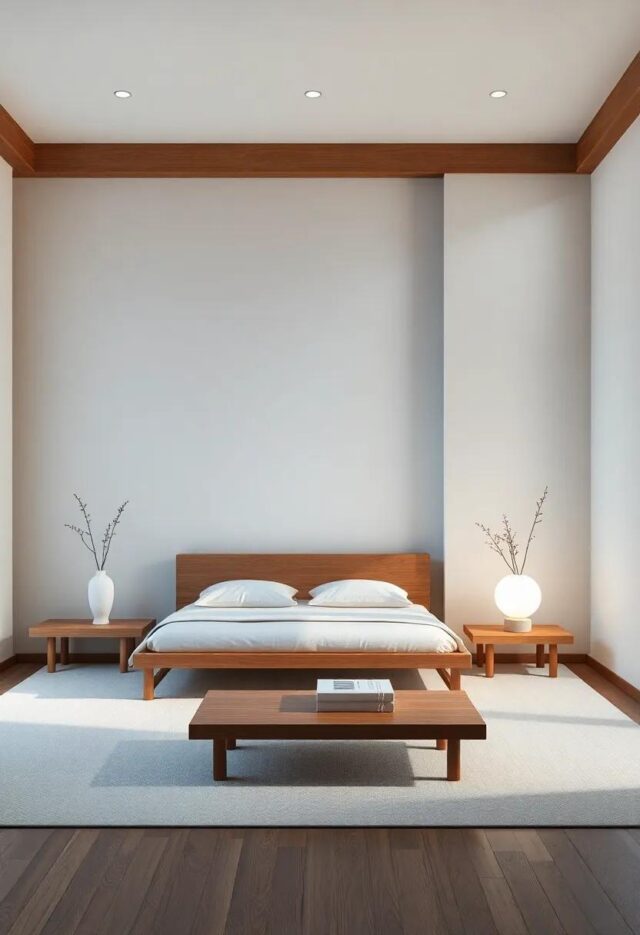In an era where life often feels overwhelmingly fast-paced, teh quest for tranquility has never been more relevant. the Japanese approach to design,rooted in simplicity and mindfulness,offers a refreshing escape into serenity,especially within the sanctuary of our bedrooms. A space dedicated to rest, reflection, and rejuvenation deserves furnishings that evoke calm and foster a connection to nature.In this guide, we will explore the elegance and functionality of Japanese bedroom furniture styles, drawing inspiration from age-old traditions that resonate with contemporary sensibilities. From the clean lines of Shaker-style simplicity to the understated beauty of tatami mats and futons, we’ll uncover how these elements harmonize to create a peaceful retreat. Join us on a journey through the artistry of Japanese design, and discover how you can transform your bedroom into a personal oasis of calm.
Embracing Minimalism in Japanese Bedroom Design
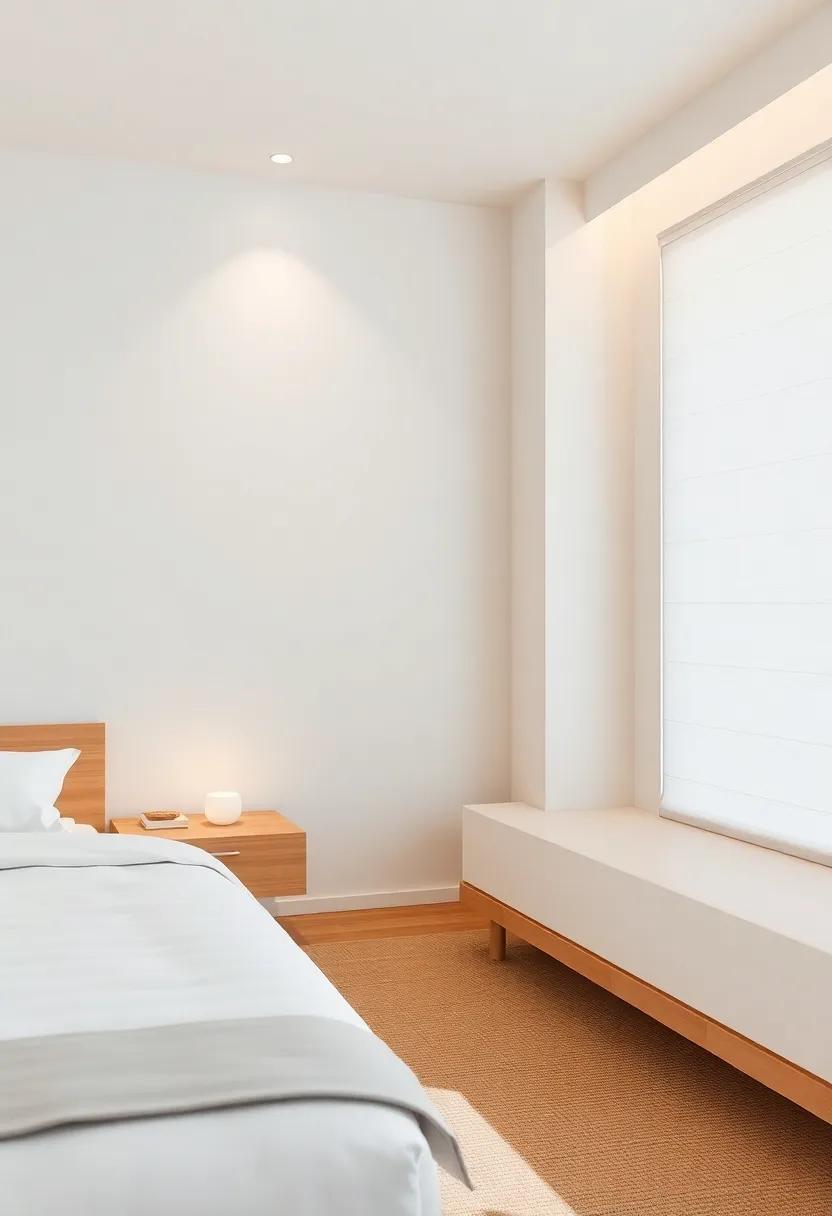
Japanese bedroom design epitomizes minimalism by favoring space, simplicity, and functionality. Key principles of this aesthetic include the use of natural materials and neutral color palettes that evoke a sense of peace and tranquility. Furniture is often low to the ground, such as platform beds and tatami mats, which not only create an illusion of expanded space but also invite a closeness to the earth. Integrating elements like shoji screens for privacy and soft lighting enhances the serene atmosphere, allowing for a seamless flow between interior spaces and nature.
Incorporating thoughtfully selected decor items, such as a simple bonsai plant or ceramic vases, contributes to the overall ambiance without cluttering the space. Emphasis is placed on high-quality craftsmanship,frequently enough seen in bespoke pieces made from wood or bamboo. To properly embody the essence of calm, aim to curate a collection of essential items that bring joy and serve a purpose.Consider using a few key elements to highlight your design:
- Natural Textures: Linen bedding, wool throws, and wooden accents.
- Functional Decor: Minimalist lamps, simple artwork, and low-profile furniture.
- Zen Elements: Indoor plants and water features.
Ultimately, embracing this style means crafting a space that encourages relaxation and mindfulness, transforming your bedroom into a personal sanctuary. By stripping away excess and embracing only the essentials, you create a harmonious surroundings that nurtures both body and soul.
Natural Aesthetics: The Beauty of Wood in japanese Furniture
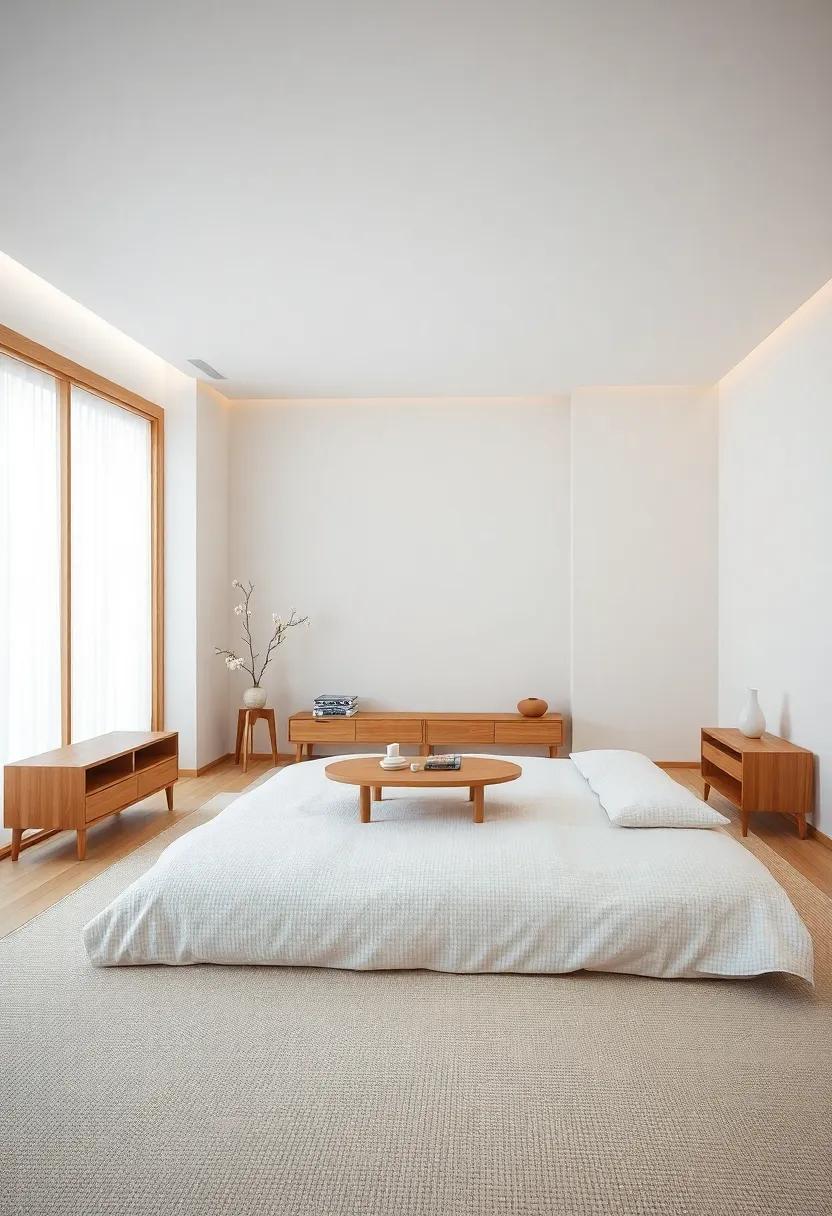
In the realm of Japanese furniture, wood is not just a material; it is indeed a fundamental aspect of design that breathes life and tranquility into the living space. Various types of wood, such as cherry, walnut, and cypress, are celebrated for their rich textures and warm hues. The craftsmen of Japan have mastered the art of woodworking, frequently enough utilizing traditional techniques that highlight the natural grain and characteristics of the wood. This attention to detail results in pieces that are not only functional but also carry a sense of timeless beauty, evoking the serene essence of nature within the home.Each grain tells a story, and every knot serves as a reminder of the tree’s journey, inviting a deeper connection to the natural world.
Incorporating wooden furniture into your Japanese bedroom design invites a calming atmosphere, promoting a sense of peace and relaxation. Consider these elements when choosing your pieces:
- Simplicity: Clean lines and minimalistic designs enhance the serene aesthetic.
- Natural Finishes: Embrace oil and wax finishes that showcase the wood’s inherent beauty.
- Functional Form: Choose items that prioritize both utility and an organic look,such as platform beds and low-profile dressers.
This harmonious blend of craftsmanship and nature encourages mindfulness, making your bedroom a sanctuary. Opting for a palette inspired by the natural world, including earthy tones and soft textures, can further enhance the tranquil atmosphere, allowing you to embrace the serenity that Japanese design embodies.
Futons and Tatamis: The Heart of a Traditional Japanese Bedroom
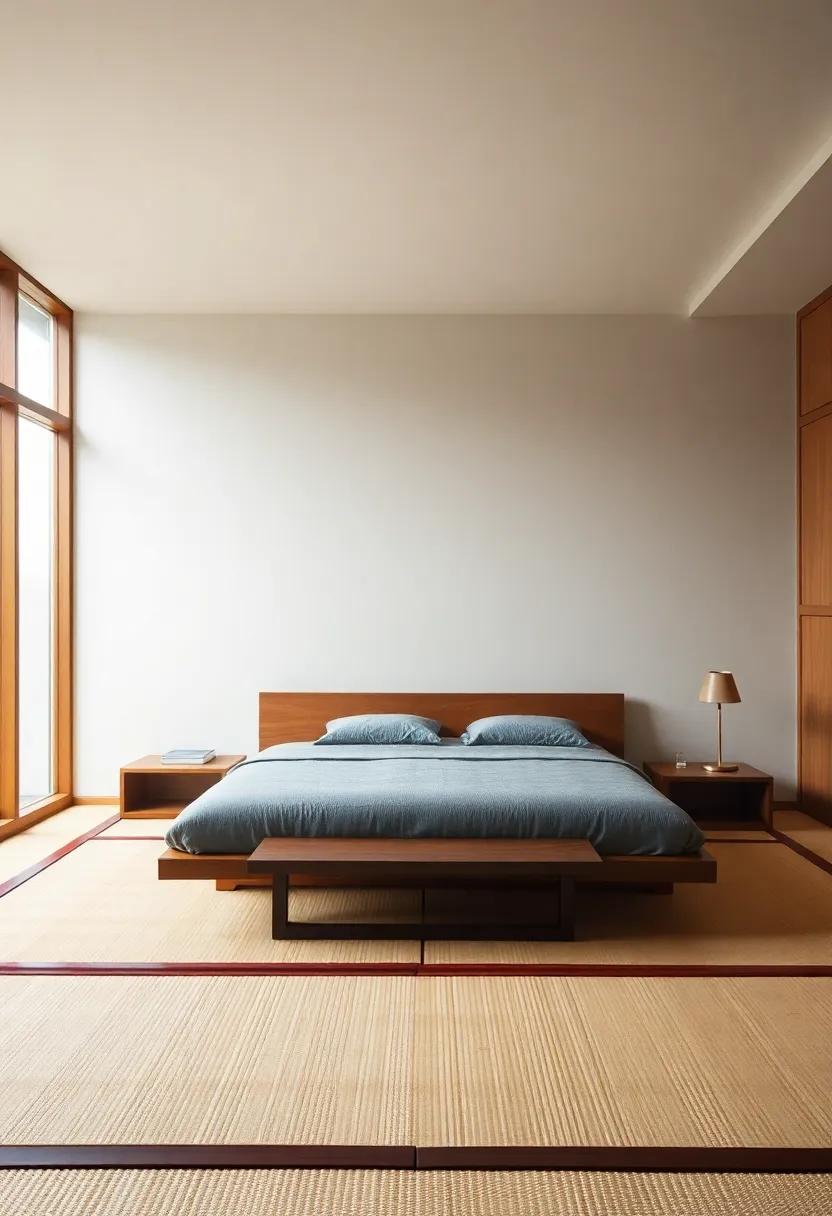
At the core of a traditional Japanese bedroom lies the harmonious interplay of futons and tatamis, two essential elements that encapsulate the spirit of simplicity and calm. Futons, frequently enough made of cotton or wool, are versatile bedding that can be easily rolled out at night and stored away during the day, allowing for a multi-functional space. Their lightweight nature encourages a return to minimalism, promoting both comfort and a sense of spaciousness. In addition, these soft layers provide excellent support for a good night’s sleep, making them a staple in Japanese households.
Complementing the futon, tatami mats serve as a foundational element that defines the ambiance of the bedroom. Traditionally crafted from rice straw and covered with woven rush grass,tatami offers a unique texture and natural aroma that enhances the sensory experience of the room.These mats not only improve insulation and sound absorption but also create a contrast that highlights the beauty of wood and other natural materials frequently enough used in Japanese furniture. To further take advantage of these elements, consider the following:
- Layer with textiles: Incorporate lovely, handwoven fabrics for added comfort.
- Natural Color Palettes: Use soothing earth tones to promote tranquility.
- Zen Accessories: Adorn your space with simple decor, such as potted plants or calligraphy art.
| Feature | Futon | Tatami |
|---|---|---|
| Material | Cotton or wool filling | Rice straw with rush grass covering |
| Versatility | Rolls up for easy storage | Fixed flooring element |
| Comfort | Soft and supportive | Natural, warm surface |
The Role of Color in Creating a Soothing Japanese Space
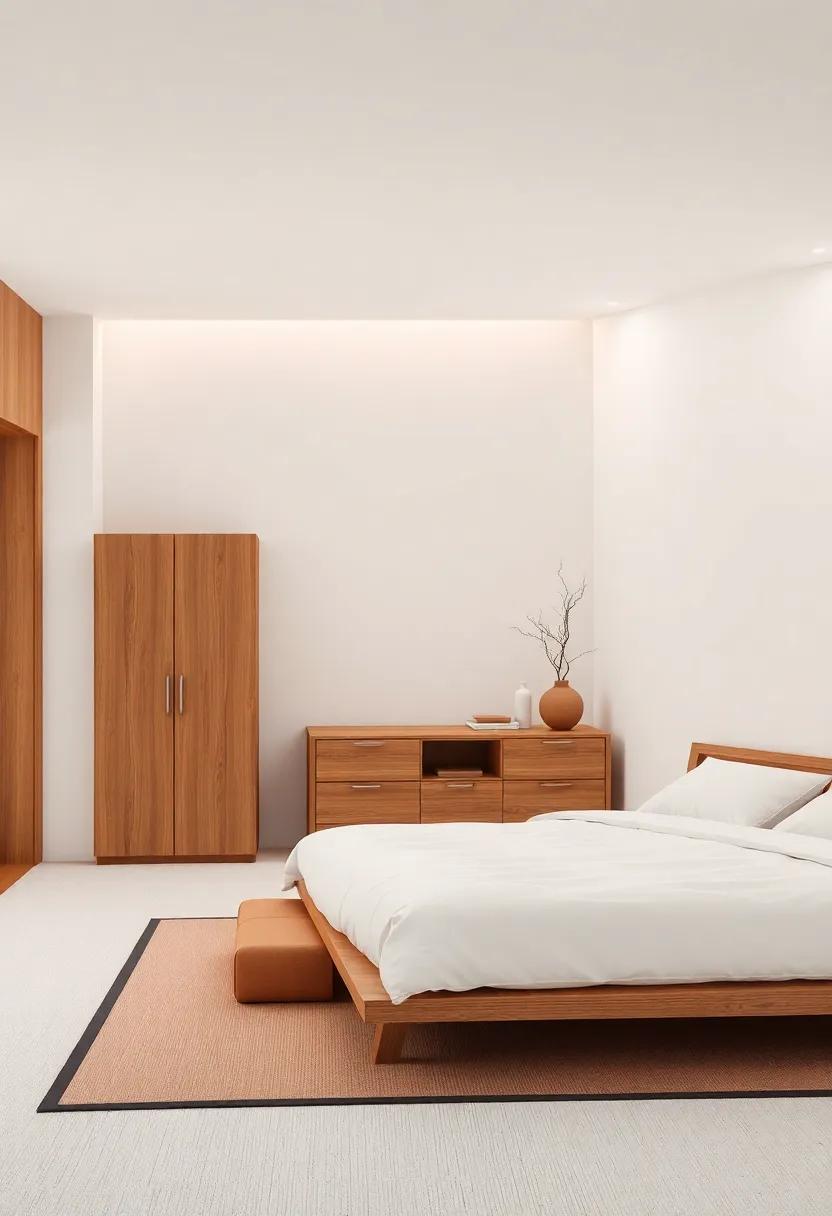
Color plays an integral role in cultivating tranquility within a Japanese space, subtly guiding the emotions of those who inhabit it. By utilizing a palette inspired by nature, such as soft greens, muted browns, and gentle blues, a sense of peace is effortlessly established. The essence of zen is embodied in these hues, promoting relaxation and mindfulness. Key color choices include:
- Earthy tones: Deep browns and soft beiges reminiscent of natural materials.
- Calming greens: Shades imitating foliage that evoke a connection to the environment.
- soft blues: Inspired by water, fostering a sense of serenity.
The careful arrangement of colors can enhance the minimalist aesthetics characteristic of Japanese design.Light-colored walls combined with darker furniture create a harmonious contrast that accentuates both space and light. To further articulate this soothing environment,consider integrating accent colors through decorative elements such as ceramics or textiles. This strategic use of color not only honors the principles of traditional Japanese aesthetics but also ensures the room remains captivating and restorative. A simple table showcasing potential color combinations can illustrate this concept:
| Primary Color | Accent Color | Emotion Evoked |
|---|---|---|
| Soft Green | Pale Cream | Tranquility |
| Light Beige | Stone Gray | Grounding |
| Dusty Blue | Warm Brown | Calmness |
Simplicity and Functionality: Essential Japanese Furniture Traits
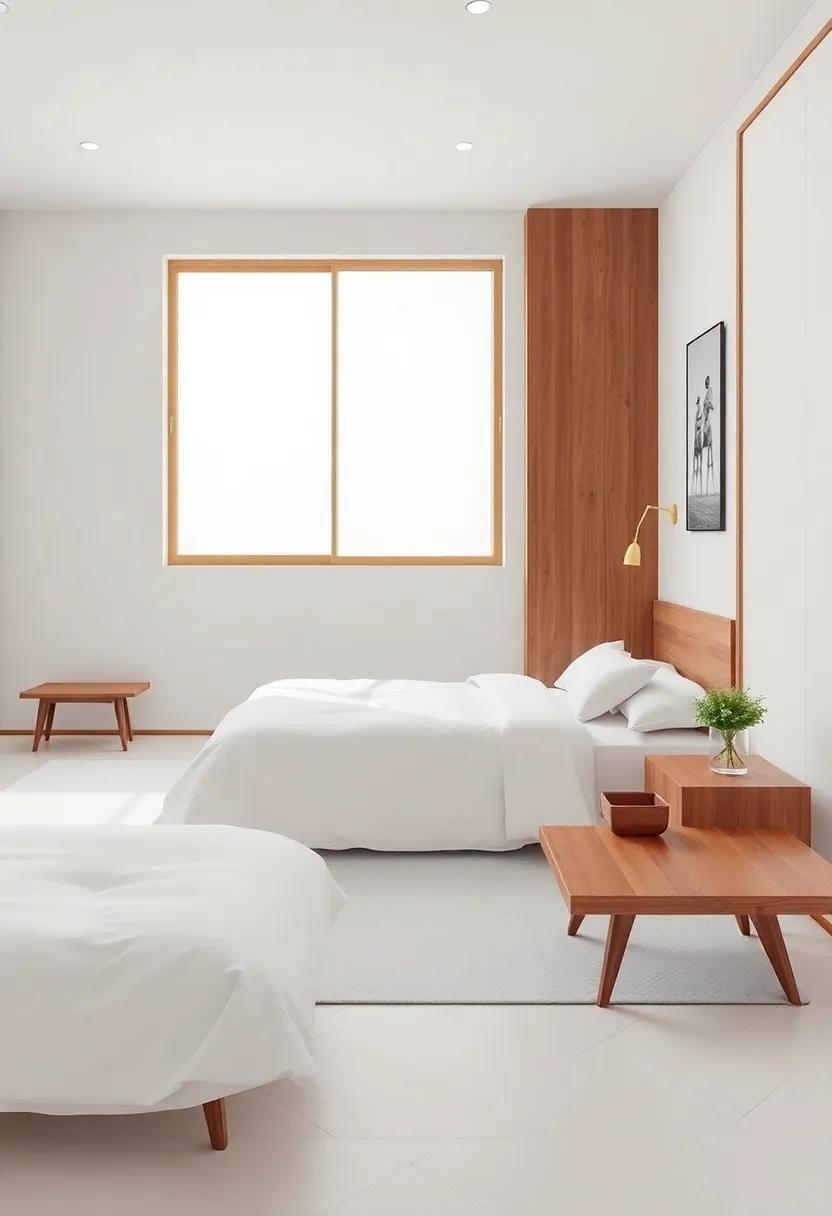
In Japanese design, furniture transcends mere functionality; it embodies a philosophy of simplicity that promotes a tranquil living environment. This aesthetic is rooted in the principle of minimalism,ensuring that every piece serves a distinct purpose while contributing to an uncluttered space. The use of natural materials like wood and rice paper is prevalent, reinforcing a connection with nature and enhancing the calming atmosphere. The beauty of Japanese furniture lies in its understated elegance, where the absence of unneeded embellishments allows the craftsmanship to shine through.
Another hallmark of Japanese furniture is its adaptability, designed to accommodate the fluidity of daily life. Key characteristics include:
- Low profiles: Furniture is frequently enough closer to the ground,enhancing a sense of peace and promoting groundedness.
- Multi-functional pieces: Ottomans that serve as storage or futons that can transform a room showcase versatility.
- Sliding doors: Shoji screens elegantly divide spaces without the weight of traditional doors,preserving open sightlines.
This thoughtful approach to design not only maximizes functionality but also invites a state of mindfulness, encouraging moments of tranquility in every corner of the home.
Sliding Shoji Screens: Blending Privacy with Light
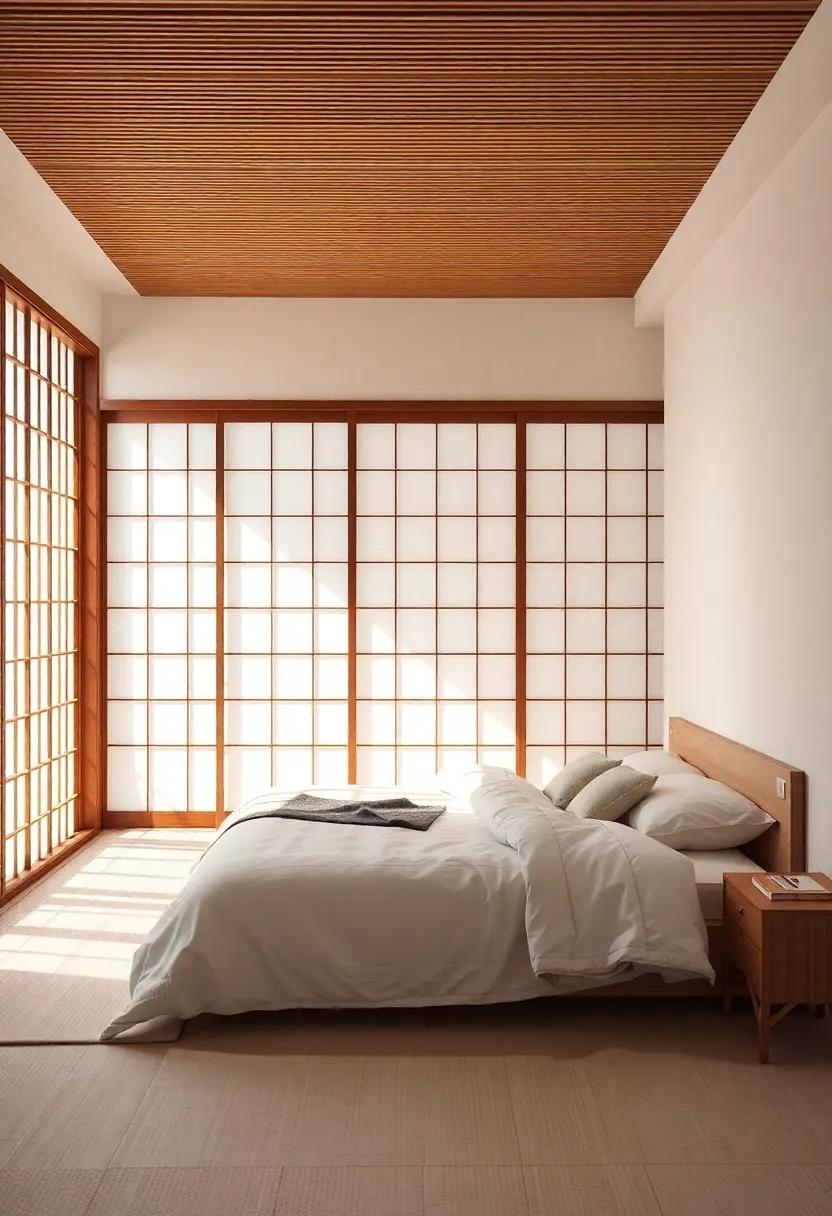
Incorporating sliding Shoji screens into your home can elevate both the aesthetic and functional aspects of your space.Traditionally crafted with thin wooden frames and translucent rice paper, these screens serve as a beautiful barrier that beautifully balances privacy and light. As sunlight filters through the delicate paper, it creates a serene glow that can transform any bedroom into a tranquil retreat. The versatility of Shoji screens allows them to be used as room dividers or even closet doors,seamlessly integrating with various styles of Japanese-inspired décor.
Beyond their functionality, sliding Shoji screens also offer a unique chance to personalize your living space. When selecting a design, consider the following elements:
- Frame Material: choose between natural wood for a classic look or modern finishes for a contemporary vibe.
- Divine Patterns: Opt for intricate designs that reflect nature or minimalist styles that promote calmness.
- Size Variations: Customize the height and width to fit your specific space requirements, maximizing both function and elegance.
This blend of privacy and light not only enhances the ambiance but also encourages a sense of openness in your sanctuary, proving that less can indeed be more in your quest for serenity.
The Art of Zen: Incorporating Elements of Nature
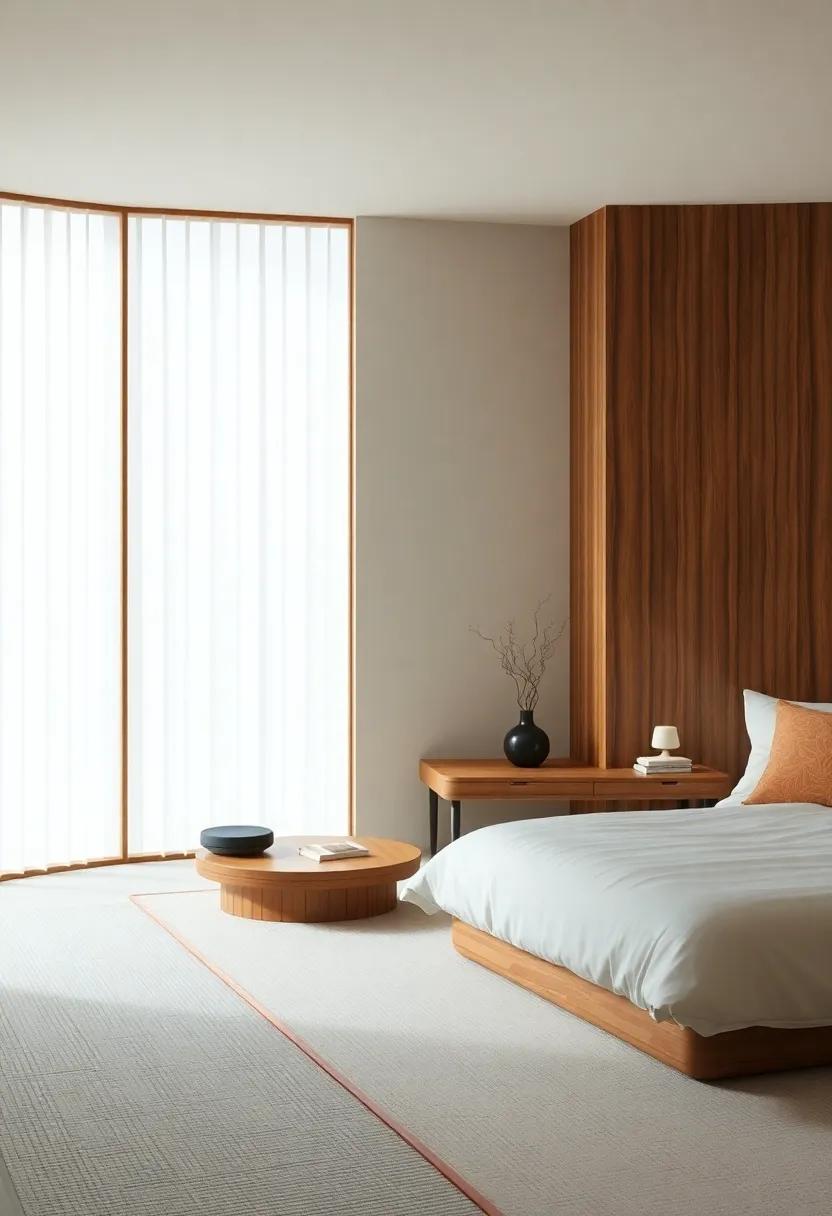
Incorporating elements of nature into a bedroom design is a practice deeply rooted in Japanese aesthetics,blending seamlessly with functionality and tranquility. To evoke a sense of calm, consider using natural materials like wood, stone, and bamboo that not only resonate with the environment but also enhance the overall serenity of the space. Soft, muted colors inspired by the natural world—like earthy browns, pale greens, and sandy beiges—create a soothing palette that invites relaxation. An essential element is to maximize natural light through unobtrusive window treatments, creating a fluid connection between the indoor space and the outdoors. Arrange furniture to allow the flow of energy, or “chi,” ensuring you can easily move around while maintaining a harmonious balance.
To further accentuate this connection with nature, curate a selection of decorative elements that evoke the simplicity and elegance of the outdoors. Incorporate indoor plants, such as bonsai or ferns, which not only purify the air but also bring a touch of life to the room. Use art pieces that feature natural landscapes or traditional Japanese motifs to create a contemplative atmosphere. Consider including items such as:
- Minimalist Wooden Mats: use tatami mats or wooden floorings that not only enhance the aesthetic but are also cozy.
- Low-profile Furniture: Select futons or platform beds that keep the room grounded and open.
- Natural Textiles: Choose cotton or linen in natural hues for bedding and cushions to maintain that aesthetic coherence.
Elegant Kakebuton: Choosing the right Bedding for Comfort
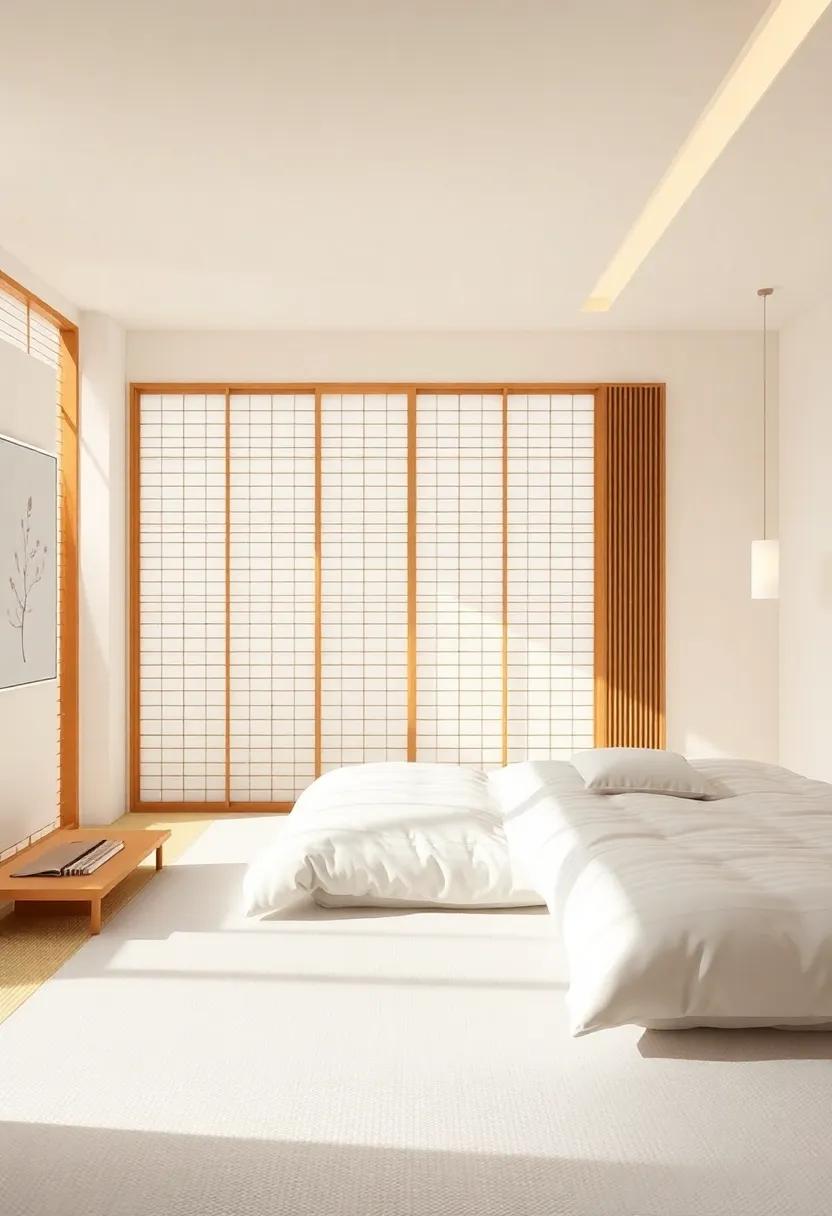
When it comes to crafting a tranquil Japanese-inspired bedroom, selecting the right bedding plays a crucial role in ensuring comfort while enhancing the overall aesthetic. Traditional Japanese bedding frequently enough includes components like futons and tatami mats, which not only provide a unique sleeping experience but also contribute to the design philosophy of simplicity and harmony.As you choose your bedding, consider the following elements to embrace both comfort and elegance:
- Material: Opt for natural materials such as cotton and linen for breathability and a soft touch.
- Color Palette: Stick to serene hues like whites, earthy tones, and pastel shades to promote relaxation.
- Textural layering: Incorporate different textures like a soft blanket or a quilt to add depth while remaining true to minimalism.
Additionally, consolidating the various elements of your bedding can accentuate your bedroom’s elegance.For a more tailored look, consider a futon cover that harmonizes with your room’s colors and patterns. A shiki futon can be neatly stored folded, maintaining the clean lines typical of Japanese interiors. When arranging your bedding, keep in mind:
| element | purpose |
|---|---|
| Futon | Provides a comfortable sleeping surface that can adapt to the seasons. |
| Tatami Mat | Offers natural cushioning and regulates humidity, enhancing well-being. |
| Throw Pillows | Adds comfort and a touch of personal flair to your bedding ensemble. |
The Influence of Wabi-Sabi in Japanese Bedroom Decor
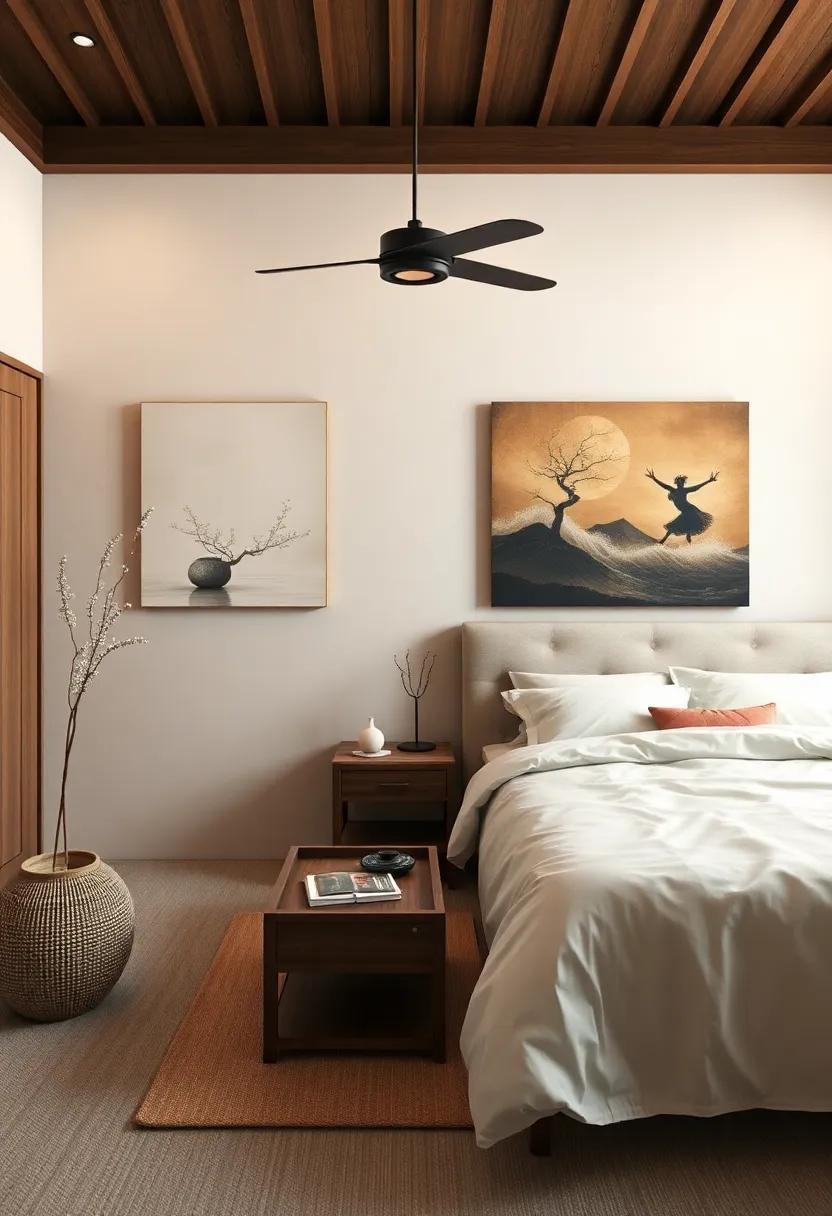
Wabi-Sabi, the Japanese aesthetic philosophy, finds profound expression in bedroom decor by celebrating the beauty of imperfection and transience. This perspective encourages a mindful approach to design, focusing on the natural materials, textures, and colors found in the environment. In a bedroom, this can manifest through:
- Natural Materials: Incorporate wood, stone, and organic fabrics.
- Earthy Color Palette: Use muted tones of greys, browns, and soft greens.
- Handcrafted Elements: Select furniture and decor that exhibit unique artistry.
By integrating Wabi-Sabi into your bedroom decor, you create a sanctuary that fosters tranquility and introspection. Consider furniture that embraces simplicity and functionality, such as low-slung beds and minimalist storage solutions. A gentle approach to decoration can be achieved by using:
- Unfinished Textiles: Use linen and cotton with a raw, natural feel.
- Subtle Lighting: Choose soft, diffused lighting to enhance relaxation.
- Live Plants: Introduce greenery that reflects the cycle of life.
Warmth and Texture: fabrics That Enhance Serenity
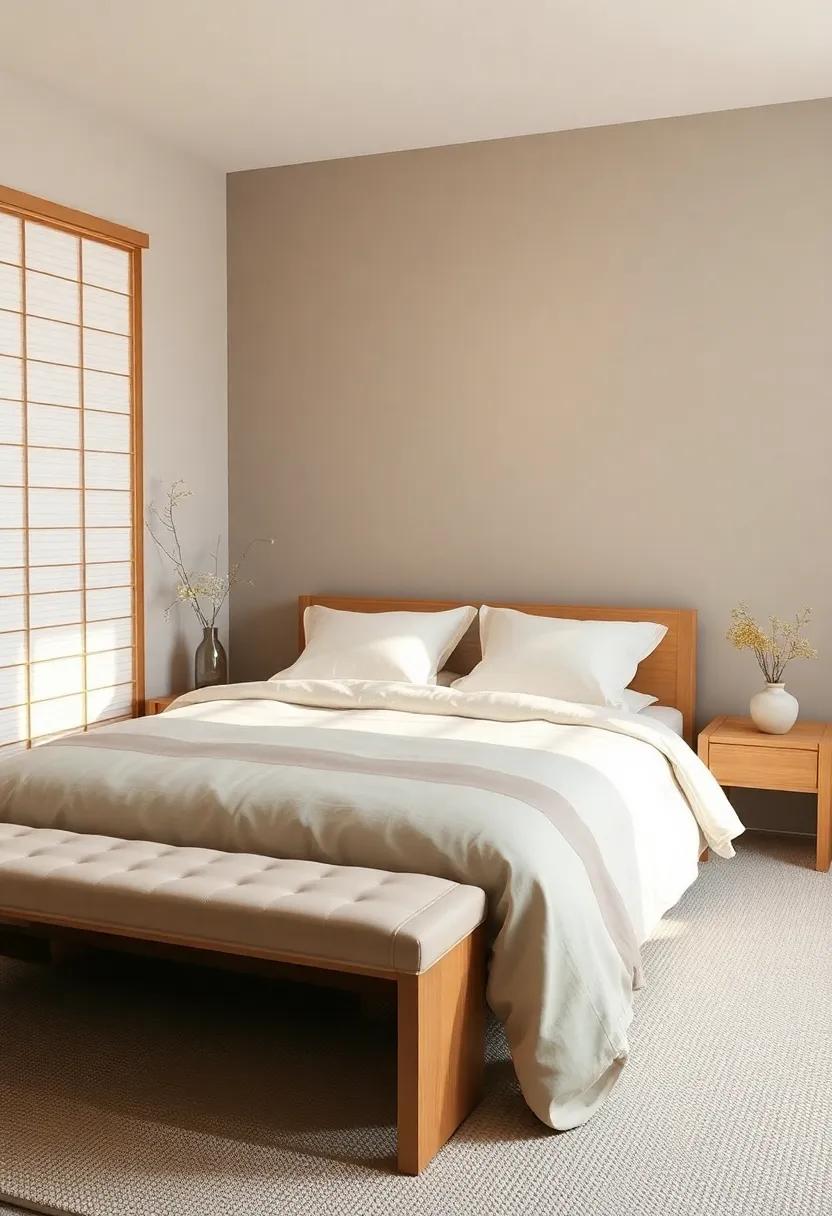
In the pursuit of tranquility within your Japanese-inspired sanctuary, the choice of fabrics is paramount. Surround yourself with materials that evoke a sense of warmth and calm, contributing to the overall atmosphere of serenity in the bedroom. Soft, natural fibers such as cotton, linen, and silk can transform your space into a haven of comfort. Consider incorporating elements like:
- Lightweight cotton sheets that allow the skin to breathe.
- Textured linen throws for cozy evenings.
- Silk cushions to add a touch of luxury.
When it comes to selecting colors and patterns, look for soft, muted tones that inspire relaxation. Fabrics in shades of beige, soft white, and earthy greens can harmonize beautifully with minimalist furniture, embodying the essence of traditional Japanese design. Adding layers through textiles not only enhances comfort but also invites a tactile experience. Here’s a brief comparison of fabric options to consider:
| Fabric | Benefits | Ideal Use |
|---|---|---|
| Cotton | Durable, breathable, easy to clean | Bedding, curtains |
| Linen | Textured, quick-drying, naturally hypoallergenic | Throws, pillow covers |
| Silk | Luxurious feel, temperature-regulating | Cushions, decorative elements |
Low Furniture: Enhancing Groundedness and Comfort
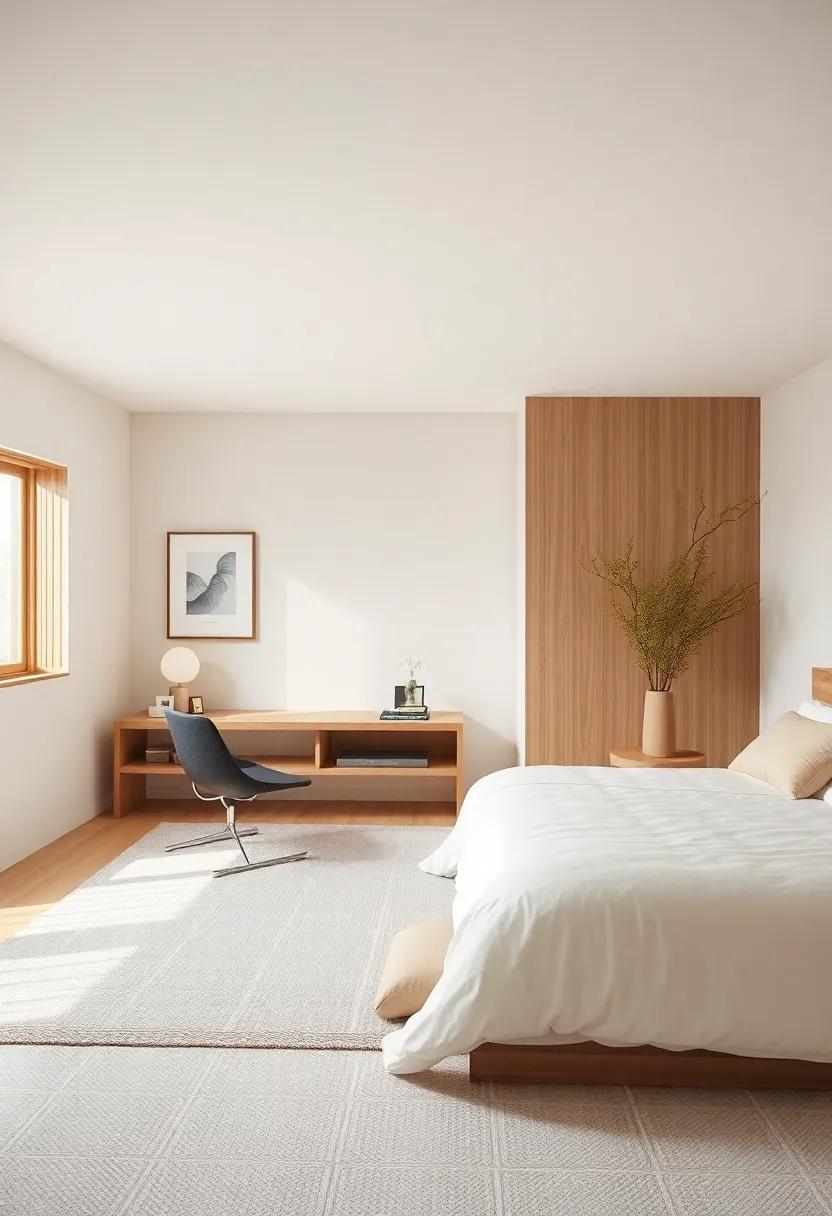
Low furniture brings a unique aesthetic to a space, evoking a sense of tranquility and a deep connection to the earth.In Japanese design, pieces like tatami mats, low dining tables, and floor cushions serve functional purposes while promoting a grounded living experience. By diminishing the verticality of furniture, these elements encourage a more intimate atmosphere that fosters relaxation and contemplation. The simple lines and natural materials used in low furniture also enhance the minimalist vibe often found in Japanese interiors, allowing clutter to melt away and providing a calm retreat from the chaos of daily life.
When incorporating low furniture into your bedroom,consider a mix of traditional and modern designs that complement your existing decor. Here are a few essential pieces to consider:
- Futon sets: Versatile bedding that folds away neatly, making the room feel more spacious.
- Masu boxes: Low wooden storage solutions that can double as seating.
- Origami tables: Multi-functional,easy-to-store pieces that add a touch of artistry.
- Floor pillows: Soft,cozy seating that promotes relaxation.
| Item | Function | Aesthetic |
|---|---|---|
| Futon | Sleep & Relaxation | Minimalist |
| Low Table | dining & Gathering | Natural |
| Floor Cushion | Seating | Comfortable |
| Masu Box | Storage | Traditional |
Japanese Cabinets: Organized Beauty in Minimalist Spaces
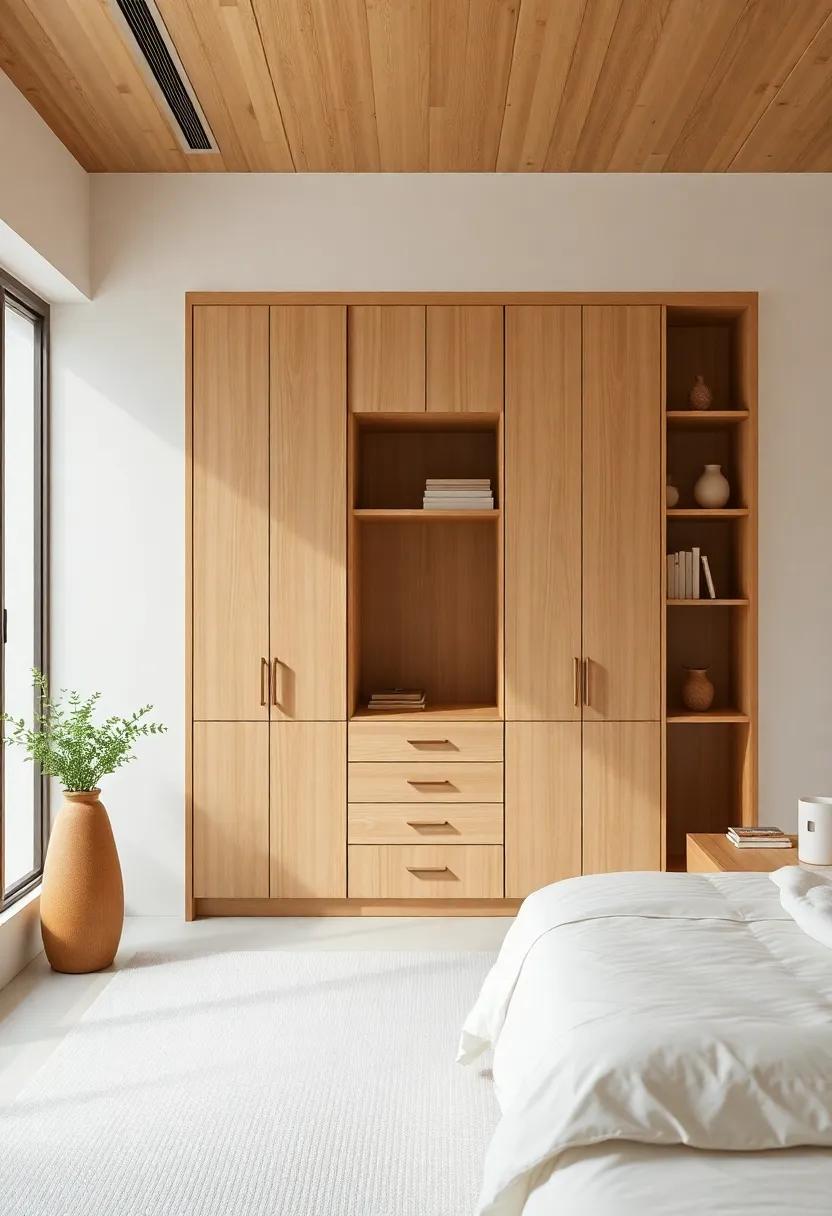
Japanese cabinets exemplify the art of minimalist design while maximizing functionality and style. Crafted with precision, thay frequently enough boast clean lines and a subdued color palette, seamlessly integrating into modern spaces.These cabinets not only serve as practical storage solutions but also as stunning focal points that bring a sense of tranquility to the room. Key features often include:
- Natural Materials: Many are made from wood,emphasizing the beauty of the grain.
- Simplicity: Minimal hardware accents enhance the overall look.
- Sliding Doors: Save space and provide an uncluttered appearance.
Moreover, these beautifully designed cabinets encourage an orderly environment, where every item has its dedicated space. Utilizing these pieces not only reflects a commitment to aesthetics but also encourages mindful living. To illustrate the versatility of Japanese cabinets, consider the following styles in various interior settings:
| Style | Features | Best Used In |
|---|---|---|
| Shaker Cabinet | Simple, flat-panel doors with minimal detailing | Traditional and contemporary homes |
| Low Buffet | Wide, low profile perfect for display and storage | dining areas and living rooms |
| Closet Armoire | Dual purpose for clothing and decor | Bedrooms and guest rooms |
Light and Space: Designing with Natural Illumination
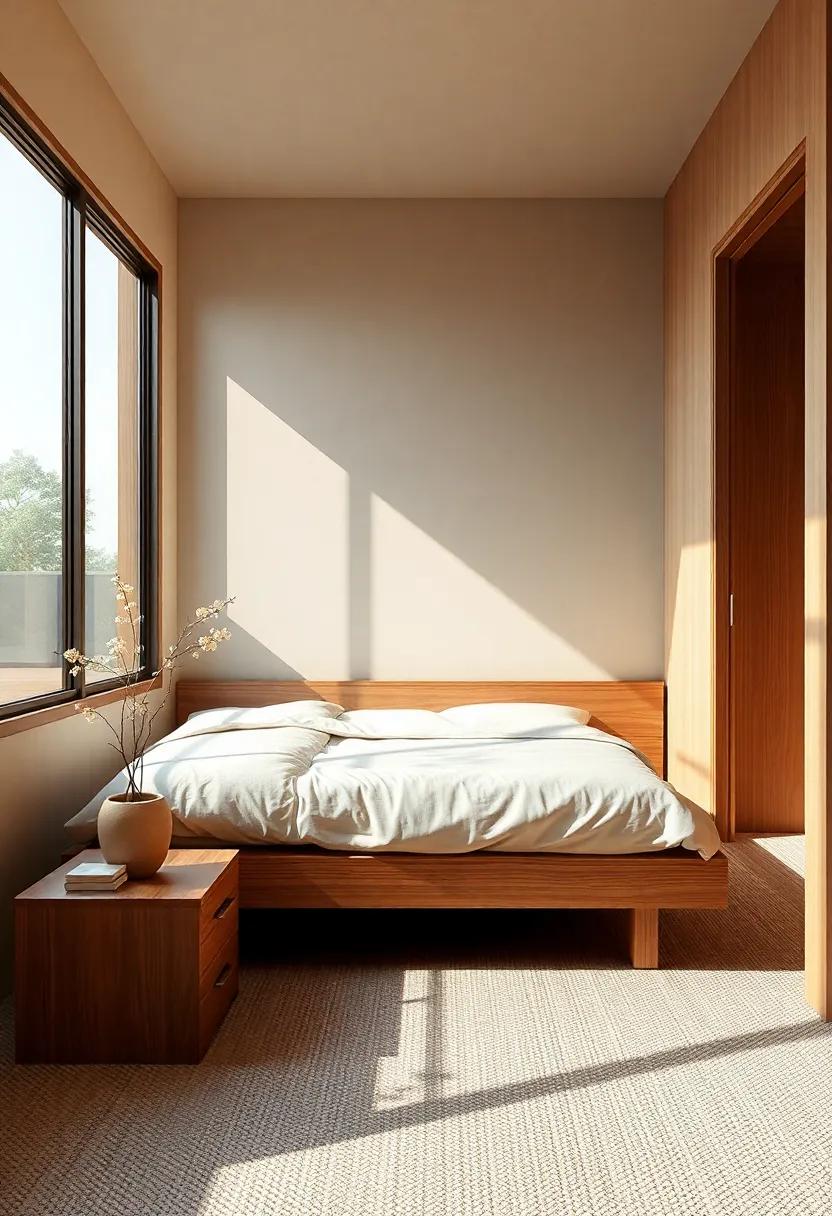
In Japanese bedroom design, the interplay of light and space is fundamental to crafting a serene environment. Large windows framed with delicate shoji screens allow natural light to filter gently into the room, creating a harmonious blend of illumination and shadow. This approach not only highlights the simplicity of furniture but also enhances the natural beauty of materials used, such as wood and paper, in traditional furnishings. Incorporating reflective surfaces like polished wooden floors or minimalist decor elements can amplify the effect of sunlight, promoting a sense of openness and tranquility.
Moreover, the arrangement of furniture in Japanese aesthetics emphasizes negative space, encouraging a flow that mirrors the surrounding nature. By keeping furniture low to the ground, such as in the use of tatami mats and futons, the room feels more expansive, facilitating a soothing atmosphere. Essential components like small, understated nightstands or kakebuton (decorative bedding) are carefully placed to maintain balance. Consider adding elements like indoor plants that thrive in natural light; they not only purify the air but also evoke a connection to the tranquil landscapes of Japan, enriching the overall experience of the space.
Incorporating Bonsai and Plants in Bedroom Design
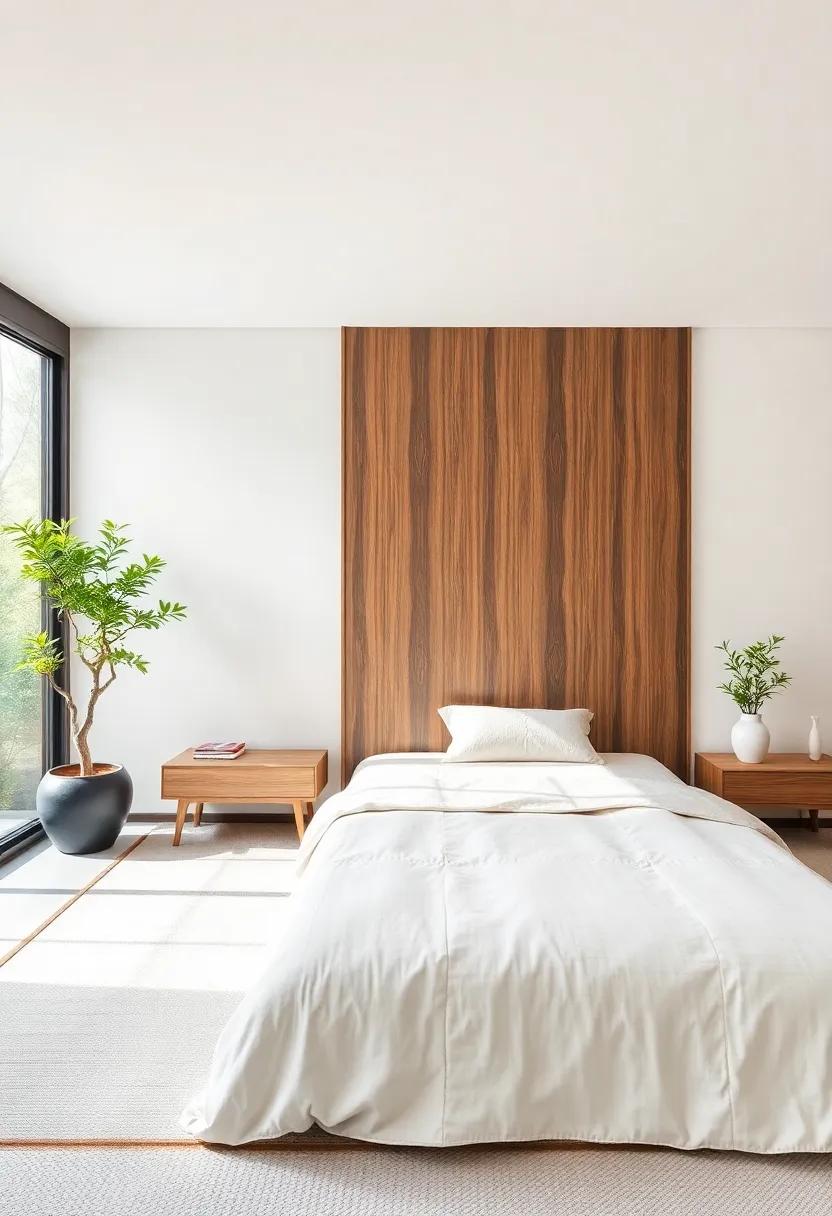
Infusing your bedroom with the beauty of bonsai and plants not only brings a touch of nature indoors but also enhances the overall ambiance of the space.bonsai trees, with their intricate shapes and calming presence, serve as stunning focal points that draw the eye and invite tranquility. To create a harmonious environment, consider placing bonsai on a simple wooden table or a low shelf, allowing their elegance to shine without overwhelming the decor. Pair these miniature masterpieces with air-purifying plants such as snake plants or peace lilies, known for their ability to create fresher air and boost mood. Grouping these plants in different sizes and pots can create a layered effect that feels both natural and thoughtfully curated.
The design aesthetic can further be enhanced by selecting decorative pots that reflect the japanese ethos of simplicity and functionality. Opt for ceramics in muted earth tones, or sleek minimalist designs to reinforce a sense of calm. Additionally, employing lighting techniques, like soft spotlights or natural light through sheer curtains, can accentuate the greenery’s vibrant hues, making them stand out beautifully against a minimalist backdrop. Consider creating a plant corner where you can enjoy some quiet time or practice meditation. This small nook should feature a comfy cushion, a bonsai, and a collection of smaller plants, serving as a peaceful retreat within your bedroom.
Chests and Dressers: Aesthetic Storage Solutions
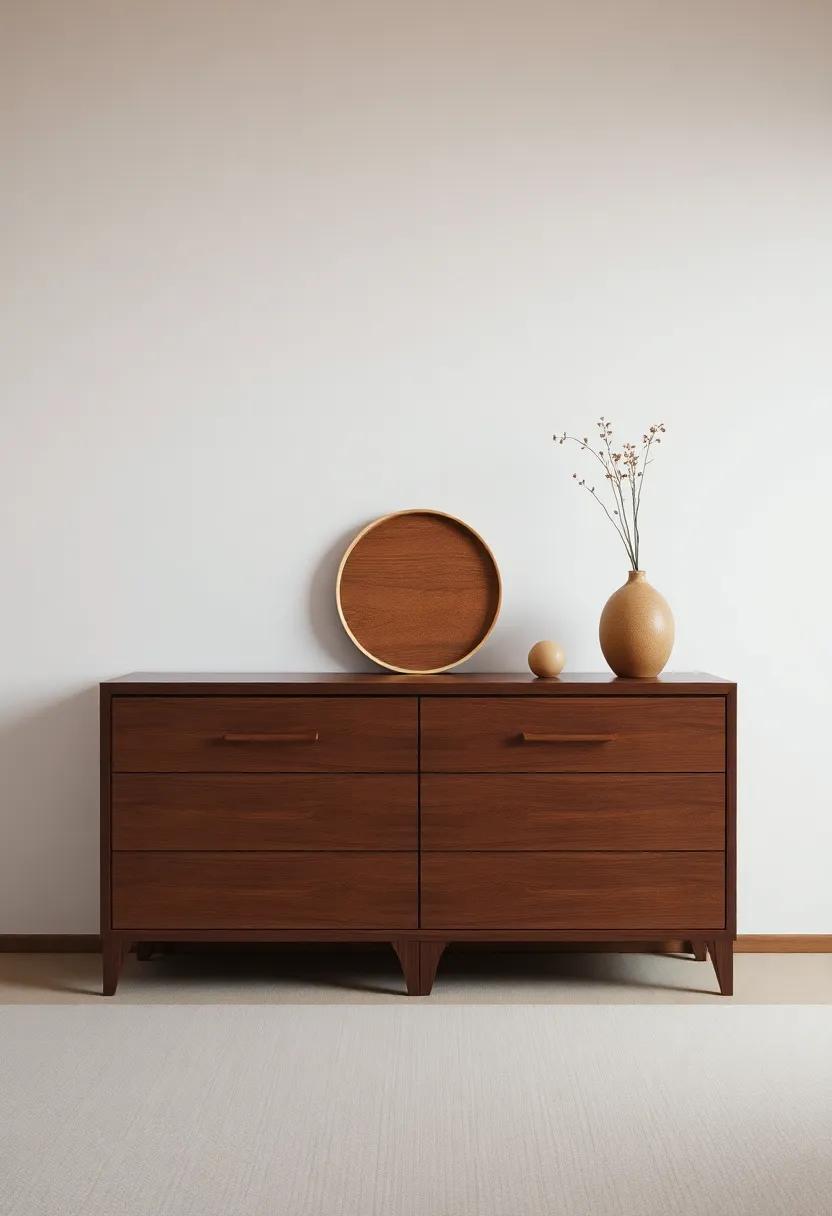
Incorporating chests and dressers into your Japanese bedroom not only enhances the aesthetic but also embraces the essence of simplicity and functionality. These furniture pieces are often crafted from natural woods like pine, bamboo, or cedar, harmonizing beautifully with the color palette typical of Japanese design. The minimalist lines and subdued hues help create a serene environment, making your space feel inviting and peaceful. Consider opting for designs that feature sliding doors or hidden compartments to keep clutter at bay, thus allowing for an uncluttered and mindful atmosphere.
When selecting chests and dressers, aim for functionality that complements your lifestyle while preserving the tranquillity inherent in Japanese aesthetics. Look for pieces that feature tatami-style bases or those with shoji-inspired details to effortlessly tie in with the theme of your room. You can also enhance the storage aspect by introducing a combination of open shelving and closed cabinetry, striking a balance between display and association. To maximize your storage solutions, consider the following features:
- Multi-functional designs that serve as both storage and seating options.
- Natural finishes that promote a warm and organic feel.
- Modular arrangements to adapt the space according to your needs.
Japanese lighting: Creating Ambiance in the Bedroom
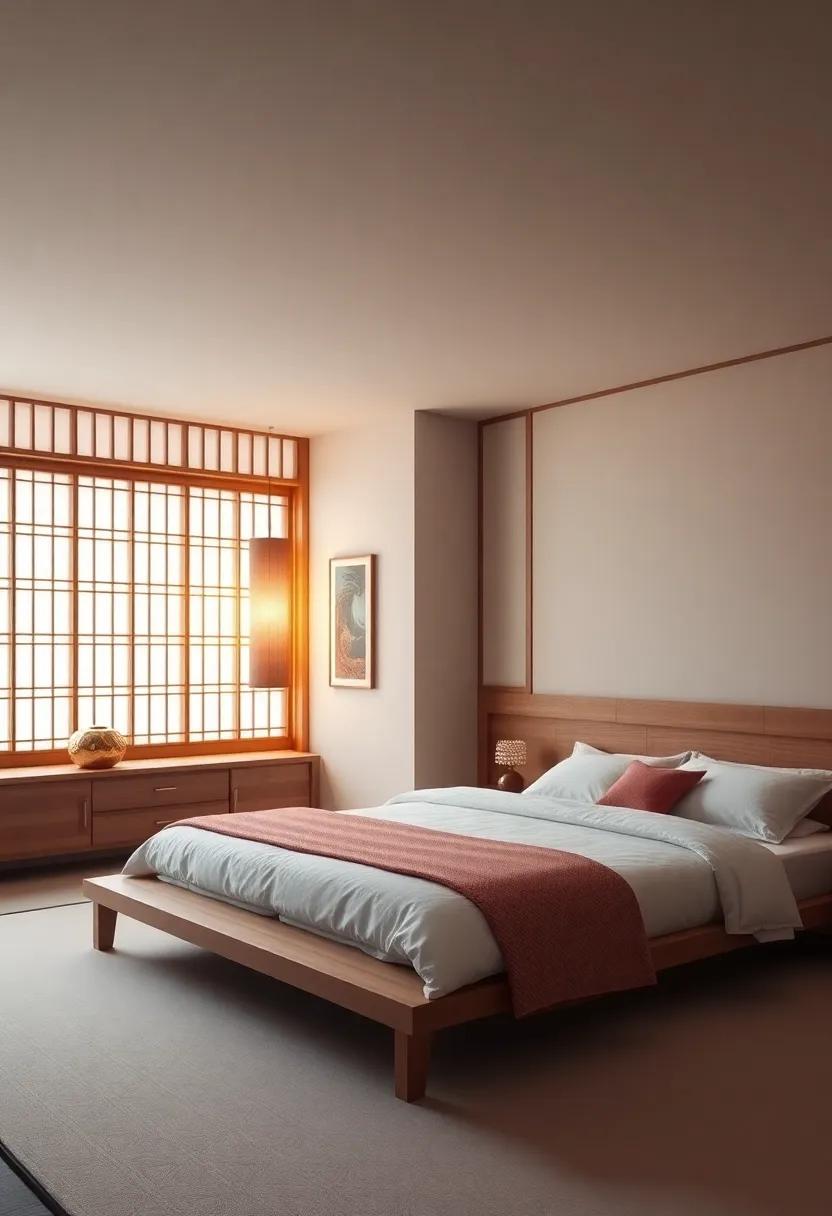
In the serene world of Japanese design, lighting plays a crucial role in crafting a tranquil atmosphere within the bedroom. Traditional japanese lighting options, often inspired by nature, bring a soft, warm glow that encourages relaxation and mindfulness. Consider incorporating elements such as shoji screens that diffuse light beautifully, or paper lanterns that add a touch of elegance without overwhelming the senses. The key is to create layers of light using a mix of ambient, task, and accent lighting to ensure the room feels both inviting and peaceful.
To enhance the soothing environment, one might also explore the use of natural materials in lighting fixtures. Here are some captivating ideas to integrate Japanese-inspired lighting into your bedroom:
- Choosing wooden floor lamps with organic shapes
- Utilizing woven bamboo shades for a touch of nature
- Incorporating low-hanging pendant lights for intimacy
- Adding candles to evoke a sense of tranquility
When all these elements come together, they create a harmonious balance that not only enhances the aesthetics of the space but also promotes a serene retreat for restful nights.
Cultural Symbols: Artwork that Defines Japanese Serenity
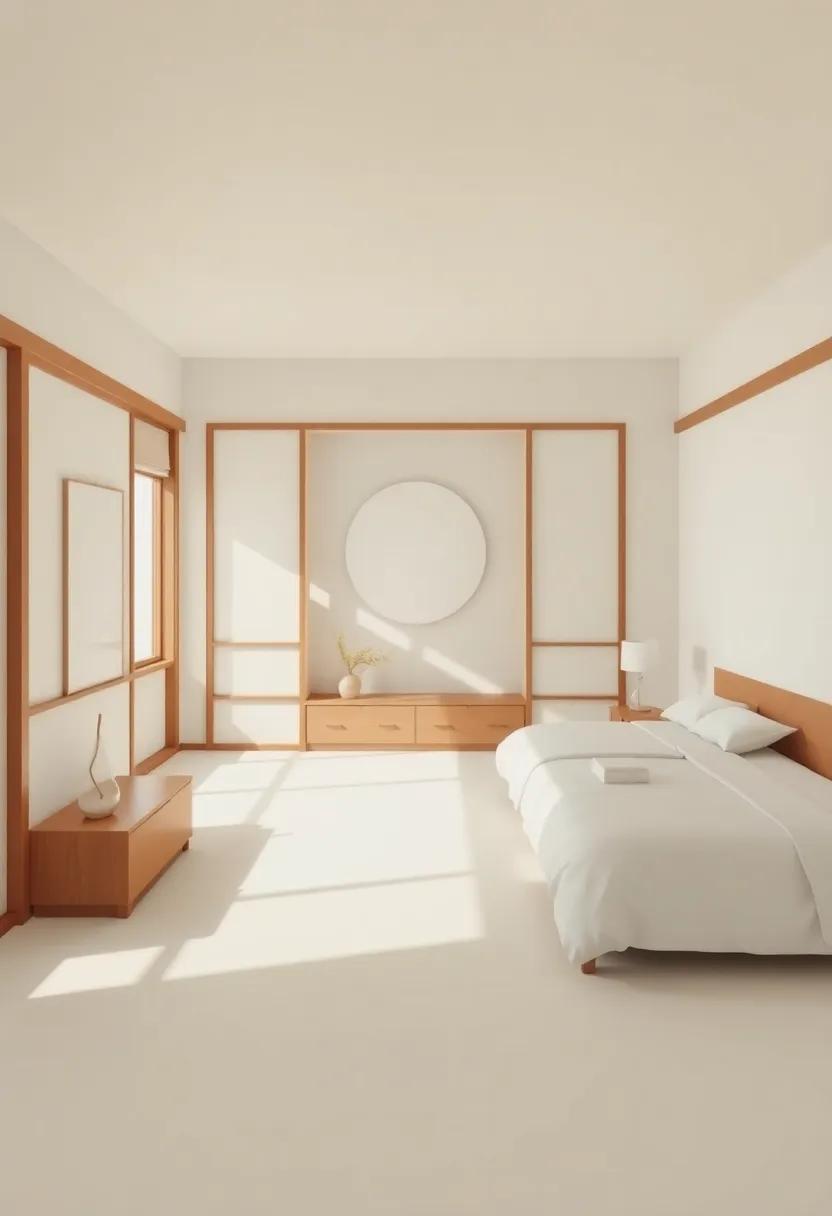
Japanese culture is deeply intertwined with elements that evoke a sense of tranquility and balance, often expressed through various forms of artwork that grace traditional and modern interiors alike. Ink wash paintings,known as suibokuga,embody the essence of simplicity and nature,often depicting serene landscapes or tranquil water scenes. Accompanying these artworks,calligraphy,featuring beautifully crafted kanji characters,reveals profound concepts and philosophies,instilling a poetic ambiance in the space. Collectively, these art forms invite a contemplative atmosphere, making them perfect for a serene bedroom setting.
In addition to paintings and calligraphy, ceramics also play an essential role in defining Japanese interiors. Items such as tea sets and vases often showcase the artistry of traditional pottery techniques, reflecting the beauty of imperfection through the wabi-sabi aesthetic. From delicate raku pieces to minimalistic porcelain designs, each piece serves not just as decoration but as a reminder of the transient nature of beauty. Integrating these cultural symbols into bedroom decor enhances the overall serenity of the environment, creating a haven of peace.
Meditative Spaces: Creating Corners for Reflection and Peace
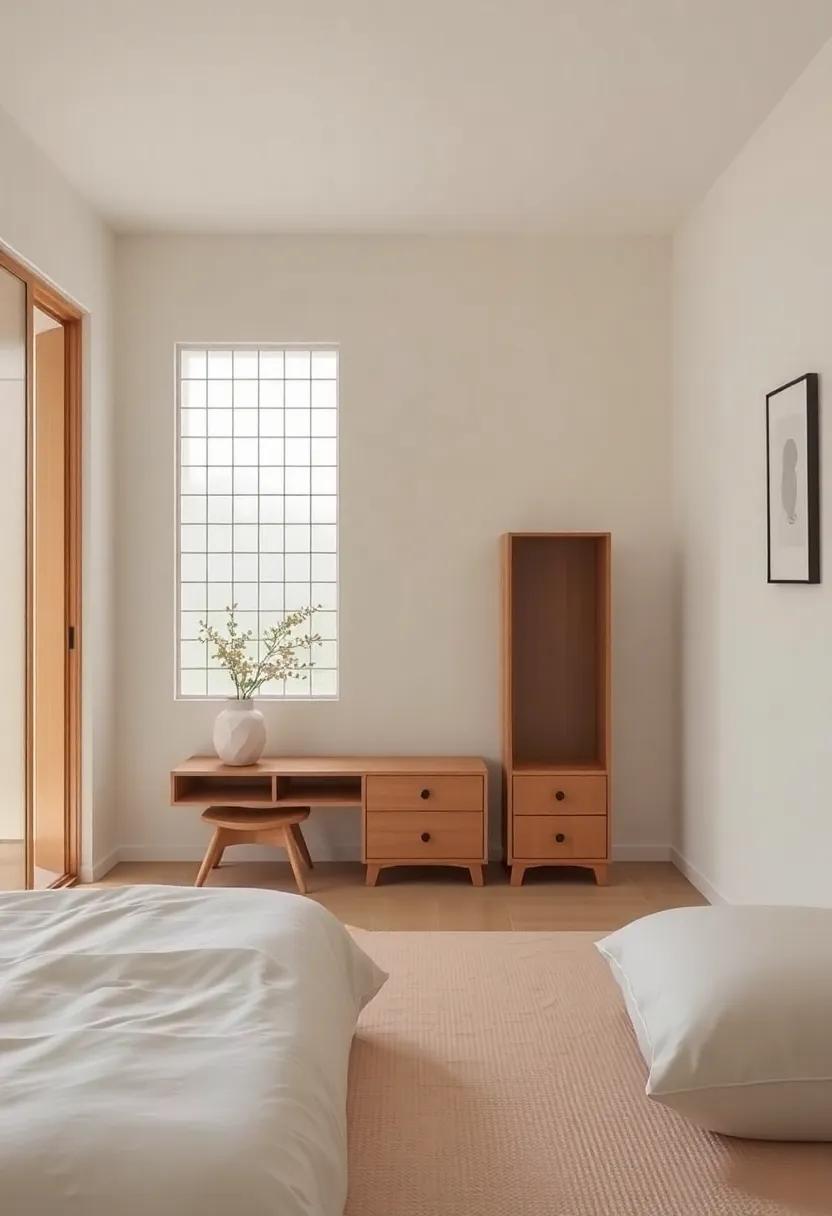
Creating a tranquil corner in your bedroom can significantly enhance your sense of serenity. To cultivate a space that encourages reflection, consider incorporating natural elements, such as plants, stones, or water features. Use soft lighting to set the mood, and opt for muted, earthy tones in your decor. Arrange your furniture thoughtfully; a low-profile futon or a tatami mat can serve as a serene seating area for meditation. Complement your space with soft cushions and a small altar or table for items that inspire you, such as candles, incense, or meaningful artifacts. This intentional setup transforms your corner into a sanctuary of peace.
To further enrich this meditative atmosphere, the choice of furniture materials plays a pivotal role. Opt for pieces crafted from bamboo or reclaimed wood, as these not only resonate with the natural aesthetics of Japanese design but also promote a sense of harmony. Consider adding a low bookshelf filled with inspirational books or poetry that stirs your soul. The integration of textiles, like a cotton or linen throw, can add warmth and texture. Here’s a quick reference table of essential elements for your reflective corner:
| Element | Purpose |
|---|---|
| Plants | Brings life and air purification |
| Soft Lighting | Creates a calming ambience |
| Cushions | Provides comfort for meditation |
| Altar/Table | Showcases meaningful items for reflection |
In Conclusion
As we conclude our exploration of Japanese bedroom furniture styles, we invite you to carry the essence of serenity and simplicity into your own home. The harmony and tranquility inherent in these designs offer not only a place for rest but also a sanctuary for rejuvenation. By embracing the principles of minimalist aesthetics, natural materials, and thoughtful craftsmanship, you can transform your personal space into a reflection of peace and clarity.
Remember, the beauty of Japanese decor lies in its ability to resonate with the rhythms of nature and life. So, whether it’s a handcrafted futon, a beautifully grained wooden dresser, or delicate paper lanterns that softly illuminate the room, every piece can contribute to a tranquil atmosphere.As you embark on your own journey to curate a bedroom that embodies serenity, let each selection be a step toward fostering a deeper connection with yourself and your surroundings.
May your newfound inspiration lead you to create a sanctuary that serves not just as a bedroom,but as a canvas for dreams,introspection,and restful nights. Embrace serenity, and allow the essence of Japanese design to guide you toward a harmonious living space that nurtures your soul.

